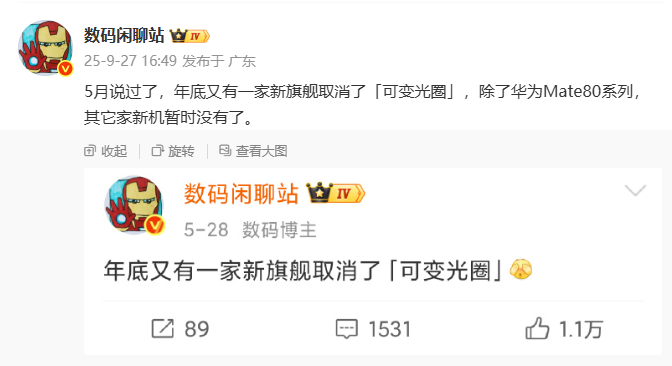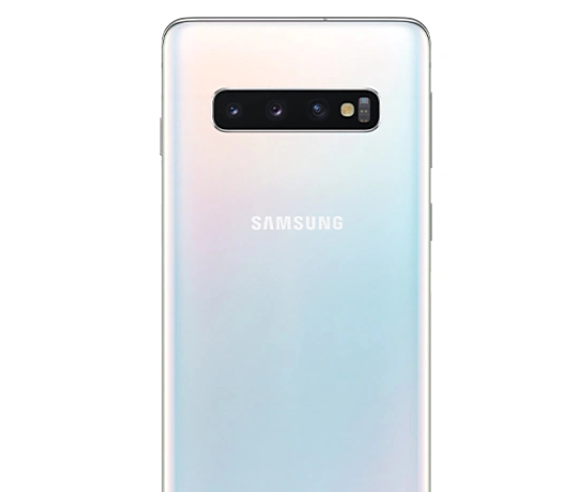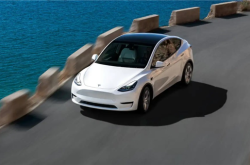The Android Camp Makes a Full Retreat! Huawei Mate80 Stands Tall with Variable Aperture, Setting Its Sights on Apple
![]() 09/29 2025
09/29 2025
![]() 623
623
Huawei harbors grand aspirations in the realm of imaging technology.
On September 28th, as per a post by the renowned digital tech blogger @Digital Chat Station, another flagship phone has bid farewell to the variable aperture feature by the year's end. At present, only the Huawei Mate 80 series continues to uphold this technology, while all other new phones from competing brands have seemingly "taken a step back." This technology, which has enjoyed just two years of popularity, is now on the brink of becoming a rare find.

Image Source: Weibo
To put it in simpler terms for those new to the concept, variable aperture is akin to the "automatic pupil" of a smartphone camera lens. It has the ability to expand and contract freely, much like the human eye.
In essence, this technology enables the smartphone lens to automatically adjust the aperture size in response to varying lighting conditions. In low-light scenarios, it widens the aperture to allow more light in, preventing photos from appearing overly dark. Conversely, when the light is ample or when you wish to emphasize the subject, it narrows the aperture to create a natural background blur, thereby making the subject stand out more prominently.
It's worth noting that Huawei wasn't the trailblazer in variable aperture technology.
Samsung had already incorporated this feature into its Galaxy S9 in 2018 and S10 series in 2019, only to discontinue it starting from the S20.

Image Source: Weibo
Why did they abandon it? At the time, speculation abounded that this technology would render the phone's camera bulkier and significantly drive up costs, leading to higher phone prices. Moreover, software-based blurring effects were rapidly improving, rendering variable aperture somewhat superfluous.
Subsequently, Xiaomi also joined the fray, introducing a two-level variable aperture on its 13 Ultra and 14 Ultra models. Huawei took it a step further, starting from the Mate 50, by offering a ten-level adjustment. The nova12 series even introduced specialized modes for portraits and star effects. There were also whispers that Samsung planned to reintroduce this feature on the S26 Ultra. However, now, on the Android front, it seems everyone has turned their back on it, which is quite perplexing.


Image Source: Weibo
Why has variable aperture technology suddenly fallen from grace? Ultimately, it boils down to cost and space constraints. Variable aperture relies on precise mechanical blades for adjustment, but these blades are costly to manufacture and occupy a significant amount of internal space, resulting in a thicker lens module.
In today's market, where everyone craves thinner phones, and with one-inch large-sensor lenses already being a premium feature, manufacturers are compelled to set aside variable aperture technology to avoid financial losses. This is why there's been chatter online about "one-inch lenses starting to downsize."
But why does Huawei persist in keeping it? According to Digital Chat Station, it's to take on Apple.

Image Source: Weibo
Recent supply chain news has confirmed that Apple is contemplating adding variable aperture to its iPhones. Next year marks the 20th anniversary of the iPhone, and a major upgrade is on the cards. Coincidentally, Samsung Electro-Mechanics has begun promoting variable aperture modules to Chinese manufacturers, clearly paving the way for Apple and leaving a backdoor open for the Android camp.
I believe, for the majority of users, variable aperture might not seem like a game-changer.
However, in the high-end smartphone market, it's all about tangible technological advancements. Imagine if the Huawei Mate 80 utilizes variable aperture for night photography, outperforming its competitors. If Apple's new phones also adopt this feature, can other smartphone manufacturers afford to stay indifferent? Once production costs decrease, they'll likely quietly reintroduce variable aperture into their phones.
Nevertheless, there's some good news: the blogger also mentioned that the telephoto macro function is unlikely to be discontinued.

Image Source: Weibo
I find this function incredibly useful, as it captures fine details on jewelry or the intricate patterns on petals and leaves with remarkable clarity. If such a practical feature were to be removed, many users would likely voice their dissatisfaction.
To be honest, variable aperture isn't just a marketing gimmick; it's a genuine necessity in photography. With variable aperture, night photography doesn't suffer from excessive noise, blurring effects are more natural, and landscape shots are less prone to blurriness. I'm eagerly anticipating what new tricks the Huawei Mate 80 can pull off and whether Apple's 20th-anniversary iPhone will dare to take on the challenge. I've already got my popcorn ready and am settled in to watch the show unfold!
Do any of you still use a phone with variable aperture? How significant do you think its role is in your photography experience? Feel free to share your thoughts in the comments section.






